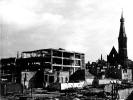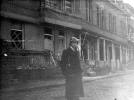 (Industrial building and damaged church)
(Industrial building and damaged church)
These building have now been identified by
Hans den Brok
of Hollnd.
The church is the Broere church which It was
located in the Broerestaat (Broere street. It was pulled down after the war.
The block - building in front was the Vroom & Dreesman (V&D) shop.
The V&D is a large chain in Holland, like McDonalds is but just smaller as
McDonalds. Most cities had or have a V&D.
In Breda allied airmen who were shot down during Market Garden
spent some time hiding at the V&D shop.
Nijmegen has still a V&D almost at the same location. I was told
that the photo was shot looking south east.
The damage was caused by the US bombing in February 1944. The
reason for this bombing is unknown. I know that the planes came in from the
East, from Germany.
|
 (Dutch
Resistance Fighter. (Dutch
Resistance Fighter.
"This was taken at 'Waalkade',
wrote Hans Brok, The Waal river flows in the back of the photographer. To
the right is the "Lage Markt".
Identified by a Dutch officer, who reported that "These men were organized into "knokploegen"
("combat groups"); these groups had contact with each other and with the Central
Command in London. They carried out sabotage raids, hit-and-run attacks etc. on
German targets. They were not full-time guerillas (as in Yugoslavia) as the
Dutch countryside is absolutely unsuitable for such actions, but were made up of
ordinary men (workers, factory owners, doctors, policemen, priests etc.) who
often didn't have any military training. A lot of them didn't make it to the end
of the war."
"Anyway," he continued, "these groups stood in close contact with a central command in London and
could be employed as [in whatever manner was] best suited [against] the
advancing Allied troops. When the Allied armies were close enough these men put
on their "uniform" and fought along with their liberators, often as guides,
interpreters or intelligence officers, but also a lot as combat troops. The
"uniform" consisted of blue or black overalls, an orange armband with "KP" on
them, a black painted Dutch M1928 helmet, and various dropped British and
captured German weapons and equipment. Below I've added a picture of a
standard M1928 helmet in the original color. The shield at the front was often
removed, but if you look closely at the above picture. you can just see the oval
shape of it under the black paint. Also note the black overall he wears."
|





